While the term “Chocolate Colored Cat” might conjure images of a rare and exotic feline, the truth is both wonderfully surprising and delightfully common. Brown cats, often referred to as chocolate in certain breeds, are not a rarity. In fact, brown, especially the classic brown tabby with its striking black stripes, is a widely seen color in the feline world. However, the solid chocolate colored cat, with its uniformly rich brown coat, presents a particularly captivating beauty that is less frequently encountered but incredibly striking. Within specific breeds, this solid brown hue proudly bears the name “chocolate,” adding to its sophisticated appeal. Even pointed breeds, like the elegant Siamese, can exhibit brown variations, known as seal point, further expanding the spectrum of chocolate shades in cats.
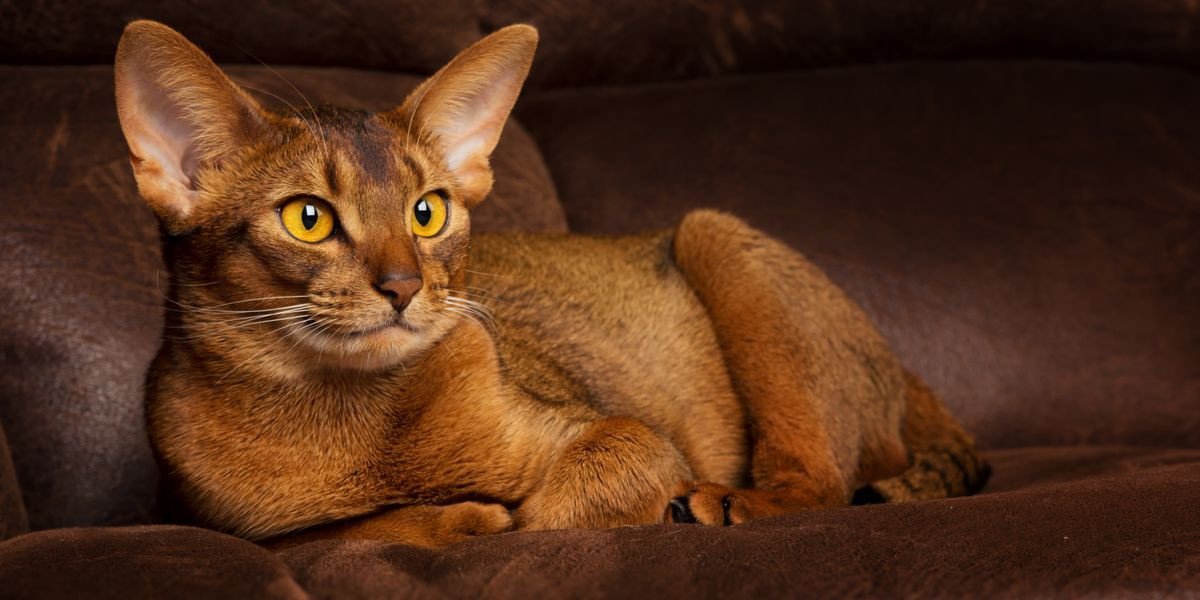 A beautiful brown cat looking directly at the camera
A beautiful brown cat looking directly at the camera
The spectrum of brown in cats is remarkably diverse, ranging from the softest tan whispers to the deepest, most decadent chocolate browns. This color palette extends across a variety of coat patterns, each adding a unique dimension to the chocolate colored cat. You might encounter the uniformly solid chocolate, the intricately patterned brown tabby, the subtly spotted brown tabby, the finely ticked brown, the boldly spotted brown, the elegantly pointed brown (often termed chocolate point), and the charming bi-colored brown and white combinations.
One exceptional purebred cat stands out, exclusively adorned in chocolate: the Havana Brown. This breed is celebrated for its consistently rich and even shade of warm, inviting brown. While the Havana Brown claims chocolate as its signature, numerous other beloved cat breeds also grace us with brown variations alongside their broader color ranges. Conversely, some breeds, such as the sleek Bombay, the shimmering Burmilla, the serene Chartreux, the silver Korat, the misty Nebelung, and the regal Russian Blue, intentionally exclude brown from their color repertoire.
Many prestigious pedigreed cat breeds, recognized by esteemed organizations like the Cat Fanciers Association and The International Cat Association, proudly feature brown within their accepted colors. Let’s embark on a journey to meet some of the most popular chocolate colored cat breeds, each with its own unique charm and story.
#1 American Wirehair: The Uniquely Coated Chocolate Cat
 A close up of an American Wirehair cat with a wiry brown tabby coat
A close up of an American Wirehair cat with a wiry brown tabby coat
The American Wirehair boasts a lineage tracing back to a single, extraordinary kitten born on a New York farm in 1966. This kitten’s claim to fame was its distinctive wiry coat, a result of a spontaneous genetic marvel. The American Wirehair’s medium-length coat is truly in a league of its own, setting it apart from all other cat breeds. Imagine a coat that is springy and dense yet resilient, with a touch of coarseness and hardness to the touch – that’s the American Wirehair.
Each individual hair is crimped, hooked, or bent, a characteristic that extends even to their whiskers and the fur within their ears. While the American Wirehair presents itself in a diverse array of colors and patterns, the brown tabby is a frequent and favored expression. Beyond their unique coat, these cats are known for their gentle, affectionate, and quiet nature, making them wonderful companions.
#2 Bengal: The Wildly Beautiful Chocolate Spotted Cat
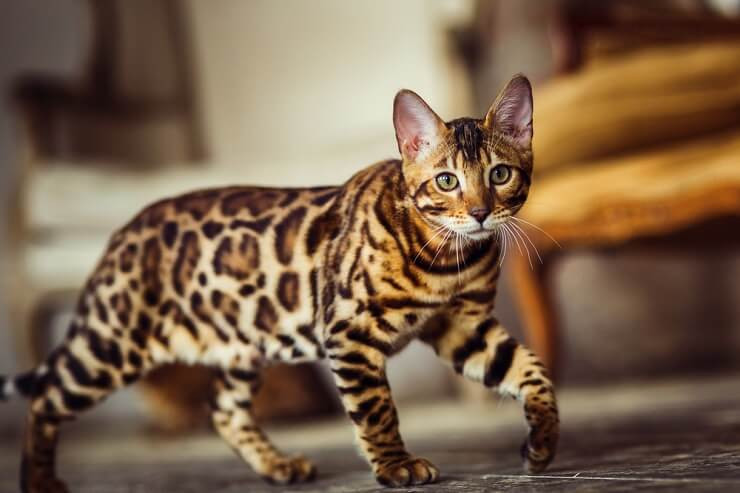 A Bengal cat with striking brown rosettes lying down
A Bengal cat with striking brown rosettes lying down
The captivating Bengal breed emerged in the 1980s from a deliberate crossing of domestic cats with the Asian Leopard Cat, a petite wild cat originating from Asia. The vision behind this breeding endeavor was to create domestic cats that mirrored the allure of wild felines while possessing loving and dependable temperaments – a goal that was brilliantly achieved. The Bengal stands alone as the only breed exhibiting rosette markings, reminiscent of the captivating patterns found on wild cats such as leopards, jaguars, and ocelots. These rosettes ideally display two distinct colors or shades, taking forms like paw-prints, arrowheads, doughnuts, half-doughnuts, or clustered arrangements. Bengals proudly showcase a variety of colors, including striking shades of brown.
Regardless of the specific color, the Bengal’s coat always features either spots or a marbled pattern and may possess a unique “glitter” effect – a special hair type that reflects light, giving the impression of a dusting of glitter. While their appearance might evoke the wild, Bengals are known for their affectionate nature and expressive vocalizations. Their high energy and curiosity demand significant engagement and stimulation from their owners, thriving on interaction and disliking prolonged periods of solitude.
#3 Burmese: The Sleek and Loving Chocolate Sable Cat
The elegant Burmese cat presents itself in a quartet of colors, with two residing within the brown family. “Sable” describes a rich, warm, sable brown, while “Champagne” offers a warm honey beige. (The remaining two Burmese colors are grey variations: “blue,” a medium gray, and “platinum,” a pale, light grey.) These four Burmese colors are a heritage from the Siamese cat, a key breed in the Burmese’s development.
The Burmese coat is a study in low-maintenance elegance. It’s remarkably short and sleek, boasting a fine, glossy, and satiny texture that requires minimal grooming. Beyond their stunning coats, Burmese cats are renowned for their intensely people-oriented and affectionate personalities, forging deep bonds with their human families.
#4 European Burmese: Expanding the Chocolate Palette
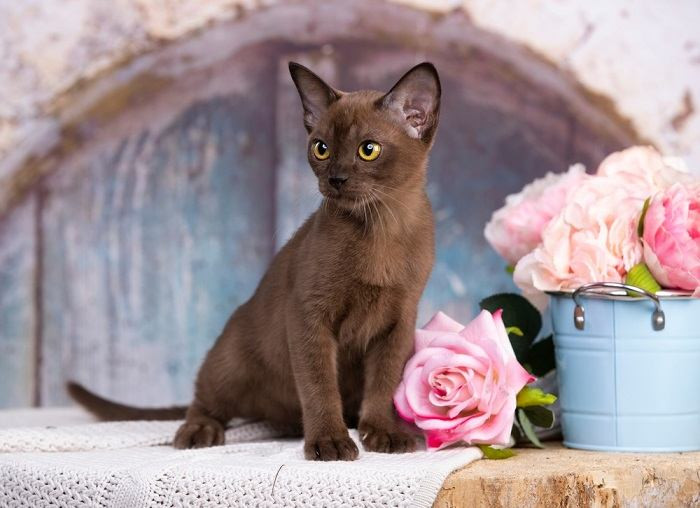 A European Burmese cat with a rich brown chocolate coat looking alert
A European Burmese cat with a rich brown chocolate coat looking alert
Closely related to the Burmese, the European Burmese represents the breed’s development in the United Kingdom, while the Burmese lineage unfolded in the United States. Both breeds trace their ancestry back to a single cat instrumental in early Burmese breeding programs in the 1930s. Though subtle distinctions in appearance and breed standards exist, the two breeds share more similarities than differences.
In contrast to the Burmese’s four-color palette, the European Burmese embraces a broader spectrum of solid and parti-colors, including “brown” (a deep, warm, seal brown) and “chocolate” (a warm milk chocolate). European Burmese cats are celebrated for their playful, cuddly, and easy-going temperaments, making them delightful companions for various households.
#5 Havana Brown: The Exclusively Chocolate Cat Breed
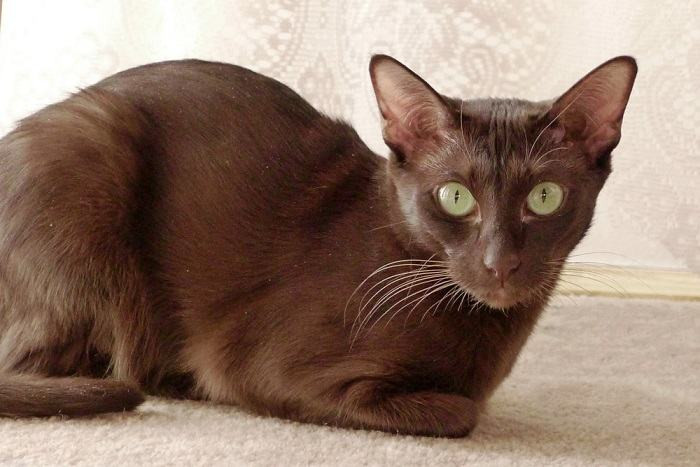 A Havana Brown cat with a uniformly rich chocolate brown coat and striking green eyes
A Havana Brown cat with a uniformly rich chocolate brown coat and striking green eyes
True to its name, the Havana Brown cat exists solely in solid brown. The specific hue is described as a rich, even shade of warm brown, leaning towards red-brown (mahogany) rather than black-brown. The Havana Brown is uniformly brown (“self-brown”), extending to its nose, paw pads, and even whiskers. Adding to its striking appearance are vivid green eyes, a captivating contrast against the warm chocolate coloration.
The Havana Brown’s coat is short to medium in length, smooth, and lustrous. Despite its suggestive name, the breed did not originate in Cuba but was developed in England in the 1950s. The name’s origin remains somewhat of a mystery, possibly inspired by the Havana rabbit (sharing a similar brown coat) or the rich brown shade of a Havana cigar. This medium-sized breed is known for its charming, affectionate, and slightly mischievous personality, bringing joy and warmth to its home.
#6 Maine Coon: The Gentle Giant with Chocolate Tabbies
 A large Maine Coon cat with a brown tabby coat sitting outdoors
A large Maine Coon cat with a brown tabby coat sitting outdoors
The magnificent Maine Coon is celebrated as one of the largest cat breeds, with males often exceeding 20 pounds. Their long, shaggy coats appear in nearly every color and pattern imaginable, with the exceptions of chocolate, lavender, and the Himalayan (pointed) pattern. Acceptable brown shades include brown with tabby markings, brown patched tabby, and these patterns combined with white.
Maine Coons naturally developed in the state of Maine, adapting to the cold environment and excelling as efficient ratters. Eventually, this breed was honored as the official state cat of Maine. Often referred to as the “Gentle Giant,” the Maine Coon is known for its friendly, laid-back nature and exceptional compatibility with children, making them wonderful family pets.
#7 Manx: The Tailless Wonder with Brown Variations
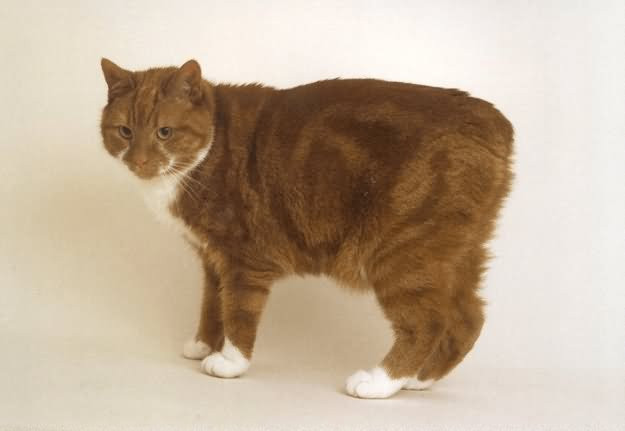 A Manx cat with a brindle brown coat standing alert
A Manx cat with a brindle brown coat standing alert
The distinctive Manx is among the select few tailless cat breeds. This breed naturally evolved on the Isle of Man, nestled in the Irish Sea between Ireland and Great Britain. While the breed’s exact age is uncertain, the Manx was recognized as a founding breed when the Cat Fanciers Association was established in 1906. Although many Manx are tailless, some exhibit partial tails, and others have full tails.
A Manx completely lacking a tail is termed a “rumpy.” A “rumpy riser” has only a slight rise of bone where a tail would begin. Only rumpies and rumpy risers are eligible for championship competition in CFA cat shows. The Manx’s double coat, available in both long and short variations, comes in a wide array of colors and patterns, including the classic brown tabby. Manx cats are known for their intelligence, active nature, loving personalities, and unwavering loyalty to their families.
#8 Munchkin: The Short-Legged Chocolate Cutie
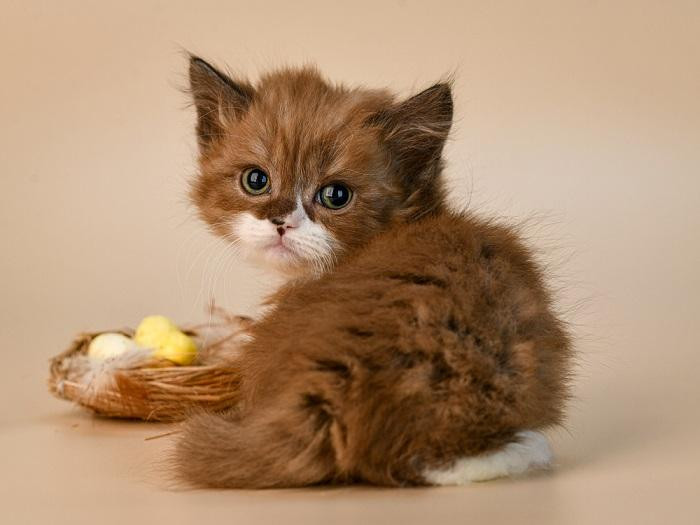 A Munchkin cat with a brown coat and short legs standing in grass
A Munchkin cat with a brown coat and short legs standing in grass
The endearing Munchkin is a dwarf breed, characterized by its charmingly short legs. It holds the distinction of being the first short-legged cat breed, originating from a spontaneous genetic mutation in a kitten born to a stray cat in Louisiana in 1983. This kitten, named Blackberry, became the matriarch of the Munchkin breed, passing on her short-legged trait to her descendants.
Named after the whimsical Munchkins from “The Wizard of Oz,” the breed gained recognition from The International Cat Association and achieved full championship status in 2003. Munchkins can have short or long coats and come in all colors, including various shades of brown. Despite their unique physique, Munchkins are a healthy breed, not predisposed to arthritis or mobility issues more than other cats. They are known for their playful, curious, and outgoing personalities, bringing joy and amusement to their homes.
#9 Oriental Shorthair: The Elegant and Expressive Chocolate Chestnut Cat
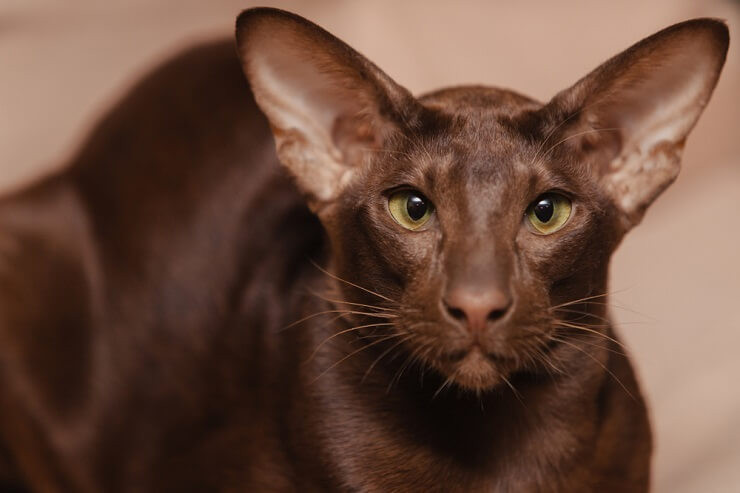 An Oriental Shorthair cat with a sleek brown coat and large ears sitting
An Oriental Shorthair cat with a sleek brown coat and large ears sitting
The sophisticated Oriental Shorthair breed emerged in England in the 1950s through the experimentation of cat breeders who crossed various breeds with Siamese cats, including Abyssinians, British Shorthairs, Russian Blues, and even mixed-breed cats. Kittens from these crossbred litters were then bred back to Siamese, resulting in a new breed that closely resembled the Siamese in its slender body and large ears but boasted a vastly expanded range of colors, patterns, and coat lengths.
Today’s Oriental Shorthair presents a rich palette of colors, including “chestnut” (a deep, chestnut brown) and “cinnamon” (a light, reddish-brown). Their coats can be short – fine-textured and glossy or satin-like – or long – medium length, fine, and silky, lacking a downy undercoat. Oriental Shorthairs are known for their active, inquisitive, and intensely people-oriented nature, thriving on interaction and companionship.
#10 RagaMuffin: The Sweet and Silky Chocolate Coated Companion
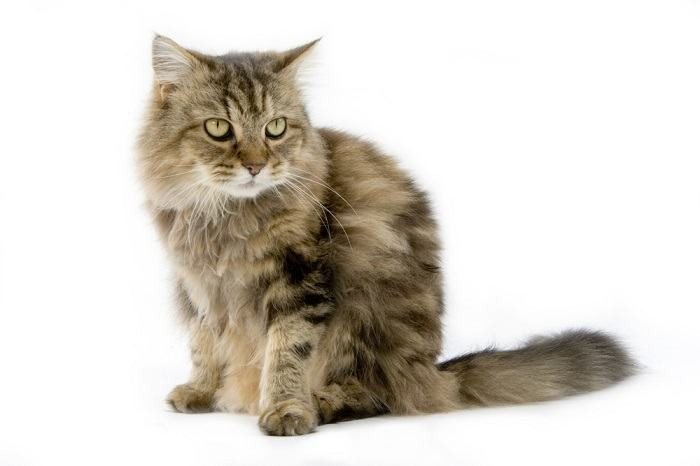 A fluffy RagaMuffin cat with a brown coat lying down
A fluffy RagaMuffin cat with a brown coat lying down
The RagaMuffin is a relatively recent breed, developed in California in the mid-1990s. While its precise origins remain somewhat veiled in mystery, it was developed using an unrecognized breed called the “Cherubim,” itself created in the 1960s from street cats. The RagaMuffin rapidly achieved standardization and gained CFA registration in 2003, with full championship status awarded in 2011.
The RagaMuffin’s coat is a delight – soft, dense, and silky, medium-long in length but surprisingly low-maintenance due to its resistance to matting. The coat is accepted in any color, including various shades of brown. RagaMuffins are celebrated for their calm, patient, and exceptionally sweet temperaments, known for their excellent rapport with children and other pets, making them wonderful additions to family homes.
Frequently Asked Questions about Chocolate Colored Cats
What Cat Breed is Specifically Chocolate Colored?
“Chocolate colored cat” describes a coat color, not a specific breed in itself, except in the case of the Havana Brown, which is exclusively chocolate. Brown is a common color in domestic shorthair and longhair cats, and many breeds feature brown, including those listed above like the American Wirehair, Bengal, Burmese, European Burmese, Maine Coon, Manx, Munchkin, Oriental Shorthair, and RagaMuffin.
Are Chocolate Colored Cats Rare?
While brown as a color is not rare, especially brown tabby, solid chocolate colored cats are less common and possess a unique visual appeal. The term “chocolate” is often used to describe a specific shade of brown in certain breeds, highlighting its richness and warmth, making them somewhat special in the broader spectrum of cat colors.
Do Very Dark Chocolate Cats Exist?
Yes, several breeds present in very dark chocolate shades. Breeds like the Burmese, European Burmese, Havana Brown, Oriental Shorthair, and RagaMuffin all feature color variations that can range into deep, rich chocolate browns, showcasing the depth and beauty of this feline color.
What is Another Name for a Chocolate Brown Cat?
In the cat fancy world, “chocolate” is indeed another name for a specific shade of brown, particularly a warm, rich brown. A chocolate brown cat with stripes is known as a brown tabby cat, continuing to use “brown” as the primary color descriptor while acknowledging the specific pattern.
